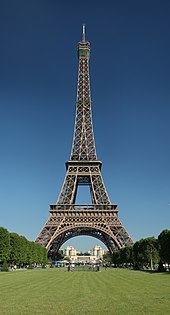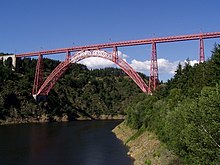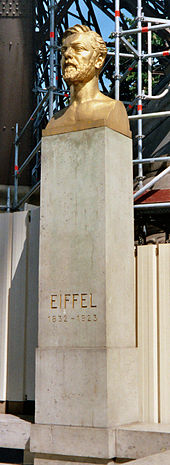Gustave Eiffel

Alexandre Gustave Eiffel [ alɛkˈsɑ̃dʁ gysˈtaːv ɛˈfɛl ] (born December 15, 1832 as Alexandre Gustave Bonickhausen called Eiffel in Dijon ; † December 27, 1923 in Paris ) was a French engineer of German ancestry .
Life
According to current genealogical knowledge, Eiffel's German progenitor is Leo Heinrich Bönickhausen , who lived in the Eifel region at the end of the 17th century .
Eiffel grew up in his birthplace, Dijon. From 1850 he attended the Collège Sainte-Barbe in Paris to prepare for the entrance exam to the École polytechnique . Failing the oral exam, he decided to study chemistry at the École Centrale des Arts et Manufactures , from which he graduated in 1855 with a diploma. After not being able to join his uncle's factories, he worked for a few months in an explosives factory in Châtillon-sur-Seine . He then worked in various design offices until, in 1856, he found a job as a bridge engineer with the western French Compagnie des chemins de fer de l'Ouest , where he first dealt with the design of railway bridges . There he made the acquaintance of the steel construction entrepreneur Charles Nepveu in the same year . He recognized his talent and made him a project manager in railway bridge construction. At that time there was a great demand for engineers in this division and at the same time there was a high turnover of personnel . Eiffel showed perseverance, diplomatic knowledge of human nature and, above all, great organizational skills in always attracting and bringing together the most suitable specialists for his projects.

In 1858 he was appointed chief engineer for the construction of a 500 meter long railway bridge over the Garonne in Bordeaux (later called the Passerelle Eiffel ), which opened in July 1860 and is considered to be his first structure. Instead of constructing the bridge - as usual - as a solid wall girder, Eiffel designed the superstructure as a light framework construction , which he also preferred in the future. This successfully completed demanding order established his good reputation in the industry.
In 1862 he married the French Marie Gaudelet, with whom he had five children, three girls and two boys. However, his wife died very early in 1877. He then married his cousin Chantall Letou. In 1866 he set up his own business, the Société de constructions de Levallois-Perret in Levallois-Perret near Paris. He was then commissioned in 1867 to build the Rouzat-sur-la-Sioule and Neuvial viaducts on the Commentry-Gannat railway line in Auvergne . The first works for the world exhibition followed in the same year . From 1872 to 1874, Eiffel was active in South America , working in Chile , Bolivia and Peru . Among other things, he was involved in the planning of the main railway stations of Santiago de Chile and La Paz in Bolivia and built several cathedrals in Tacna , Arica and Chiclayo . In 1875 he was responsible for the construction of the Western Railway Station in Budapest , which was completed in 1877, he was commissioned to build the Ponte Maria Pia in Porto (opened on November 4, 1877) and the Ponte Dom Luís I in Porto (October 31, 1881). In 1880 he was awarded the contract for the construction of the Garabit viaduct , which attracted attention because of its height (122 meters) and its curved shape and could not be opened until July 1888. In 1879 he began developing an ingenious support system for the supporting structures of the inner support structure of the Statue of Liberty in New York , designed by the Frenchman Frédéric-Auguste Bartholdi , whose inauguration took place on October 28, 1886. Between 1881 and 1882, Eiffel built Szeged 's Belvárosi Bridge in Hungary .
The Dictionnaire des Francs-Maçons Européens names Eiffel as a member of a lodge of the Grand Orient de France , but without naming the lodge specifically. Although the significant creative and financial involvement of the Freemasons in the Statue of Liberty seems to confirm membership, since the date of admission and the specific name of the lodge are not generally known, membership is considered controversial.
His most important project was preceded by a patent application dated September 18, 1884 "for a new process that allows metal pillars and pylons to be built of a height that may exceed three hundred meters". It was the Paris Eiffel Tower named after him , which, since construction began on January 26, 1887, was completed in just 26 months on March 31, 1889 and celebrated its opening on May 15, 1889. The design was by architect Charles Léon Stephen Sauvestre , based on a construction idea by Maurice Koechlin . It was intended for the Paris World's Fair in 1889 and was built under Eiffel's supervision. Initially not accepted by the Parisian population, the tower quickly became the internationally recognized symbol of Paris and France.
Even before the construction of the Eiffel Tower, Gustave applied for the change of his family name - unpronounceable for the French - to "Eiffel", which a court in Dijon ordered on December 15, 1880. Meanwhile, at the end of 1887, Eiffel signed the most momentous contract of his career, when he was to supply 30 locks for the Panama Canal planned by Ferdinand de Lesseps , which were to be installed from January 1, 1888. After the Panama Company filed for bankruptcy in February 1889, Eiffel was found guilty of default in 1893. He then handed over his company Eiffel & Cie. to his employee Maurice Koechlin and withdrew from the business. In the early 20th century, Eiffel pioneered the field of wind tunnels with experiments to study the drag of various geometric shapes, laying the foundation for modern aircraft design .
Gustave Eiffel died in 1923 at the age of 91 and was buried in Levallois-Perret Cemetery , northwest of Paris.
The name "Eiffel"
Gustave Eiffel's paternal ancestors bore the name "Bonickhausen-Eiffel" or "Bonickhausen dit Eiffel" (" called Eiffel"). The German spelling of the name Bonickhausen is "Bönickhausen" with umlaut characters . The oldest verifiable ancestor of the Bönickhausen family in France is Jean René Bönickhausen, who married Marie Lideriz on 30 April 1711 at the Duke of Gramont 's house on rue Neuve Saint-Augustin in the Parish of St-Roch , Paris , and as an employee of the ferme générale died on January 7, 1734 at the age of 75 in Saint-Valery-sur-Somme in Picardy . The suffix "dit Eiffel" (called Eiffel) can be found in his death entry.
The writer and Eiffel biographer François Poncetton and the former general director of the French archives, Charles Braibant , suggested that the oldest ancestor in the French line, Jean René Bönickhausen, came from the family of the Eifel schoolmaster Leo Heinrich Bönickhausen . At the end of the 17th century he lived in Aremberg , district of Ahrweiler , and in Marmagen , district of Euskirchen , and served there as ludimagister (schoolmaster) and sacristan in church services. Going back to Braibant, the explanation has spread that his son Wilhelm Heinrich, baptized in Marmagen in 1680, emigrated to France around 1710 and called himself Jean René Bönickhausen there with the addition Eiffel. However, this assertion, which is often found in existing Eiffel biographies, is unproven.
"Bonickhausen dit Eiffel" is also entered in Alexandre Gustave Eiffel's birth certificate. On the edge of the document, however, there is a note that the court of first instance in Dijon issued a ruling on December 15, 1880 that the name "Eiffel" was to be used instead of "Bonickhausen dit Eiffel". On October 30, 1878, he applied to the Ministry of Justice for his name to be shortened and gave detailed reasons.
Other important buildings
- Galerie des Machines , Paris World's Fair 1867, demolished 1909 (other source: 1910)
-
Ruhnu tuletorn lighthouse on the Estonian island of Ruhnu , built in 1875

- Ponte Eiffel in Viana do Castelo in Portugal (1878), truss bridge over the Rio Lima
- Main dome of the Observatoire de Nice , built in 1879
- Palácio de Ferro (Iron Palace), built in France and brought to Luanda
- Palacio de Hierro de Orizaba , components shipped to Mexico from Belgium
- Casa de Ferro in Maputo
- Souleuvre Viaduct , Normandy , built 1887
- Railway bridge in Münchenstein near Basel collapsed in 1891 due to a construction error, see also Jurabahn
- Vecchio railway viaduct in Corsica
- The Basílica de San Sebastián in Manila was built in the neo-Gothic style . It was constructed entirely of steel based on Gustave Eiffel's designs.
- Real Bodega de la Concha ( Sherry warehouse in Spain , 1869)
- In 1892 he took part in the competition for the construction of the Trinity Bridge in Saint Petersburg . Although another French company carried out the construction, they took inspiration from Eiffel's project.
- Hotel Traian in Iasi (Romania)
- Railway bridge over the Prut near Ungheni (Moldau)
- Train station roof of Santiago de Chile
- La Casa de Hierro, the Iron House, in Iquitos , Amazonia/Peru
- Church of Santa Barbara, Santa Rosalía , Mexico
- Suspension bridge at Ste-Anne, Réunion
- Viaduct at Buis-les-Baronnies on the Orange–Buis-les-Baronnies narrow-gauge railway , demolished after closure in 1953
- Western Railway Station in Budapest , 1874–1877
Others
- 2021 saw the release of the film drama Eiffel in Love , which tells a fictional love story between Eiffel and a married woman. Romain Duris plays Gustave Eiffel .
writings
- The Resistance of the Air and the Aviation. Paris: H Dunod et E Pinat, 1910.
- Les new experimental researches on the resistance of the air and the aviation. 1914
literature
- Theo Zollna: Eiffel - On the 35th anniversary of the death of the great civil engineer. In: Deutsche Architektur , 1st issue, 1959, p. 43f.
web links
- Literature by and about Gustave Eiffel in the German National Library catalogue
- biography
- Association Gustave Eiffel (French)
- Association Monneuse et Moneuse (German)
- Newspaper article about Gustave Eiffel in the 20th Century Press Kit of the ZBW – Leibniz Information Center for Economics .
itemizations
- ↑ Extract from the Dijon birth register, 713/1832, drawn up on May 13, 1878. Archives Nationales, dossier LH/892/60. Online at Base Léonore (accessed September 1, 2015)
- ↑ David I Harvie, Eiffel: The Genius Who Reinvented Himself , 2013, p. 1
- ↑ Gustave Eiffel : Sa Vie, detailed biography. In: gustaveeiffel.com. Association des Descendants de Gustave Eiffel, accessed November 16, 2011 (French).
- ↑ Le Grand Journal de Bordeaux, Histoire des maires de Bordeaux , 2008, p. 321
- ↑ Gerhard Mehlhorn/Manfred Curbach (eds.), Handbook Bridges: Design, Construct, Calculate, Build and Maintain , 2014, p. 49
- ↑ Klaus Stiglat, Bridges along the way: early iron and concrete bridges in Germany and France , 1997, p. 86 ff.
- ↑ Karl-Eugen Kurrer : The History of the Theory of Structures. Searching for Equilibrium . Ernst & Sohn , Berlin 2018, ISBN 978-3-433-03229-9 , pp. 75ff. (German: History of structural engineering: in search of balance ISBN 978-3-433-03134-6 )
- ↑ Michel Gaudart de Soulages, Hubert Lamant: Dictionnaire des Francs-Maçons Européens. Coulommiers: Dualpha 2005, p. 337
- ↑ Philip Militz: Masons in 60 minutes. Editor: Jonathan Byron. Thiele Verlag, Munich 2009
- ↑ after the German low mountain range Eifel , which was written "Eiffel" until around 1850
- ↑ État-civil de la Côte-d'Or, Dijon, Registres d'état civil (birth and name registers) 1832, p. 249 , accessed 8 August 2011
- ↑ knerger.de: The grave of Gustave Eiffel
- ↑ a b c d Charles Braibant: Histoire de la Tour Eiffel. Paris 1964, p. 35
- ^ François Poncetton: Eiffel: Magicien du fer. Paris 1939
- ↑ e.g. B. Henri Loyrette: Gustave Eiffel. An engineer and his work. Stuttgart 1985
- ↑ National Archives: BB/11/1473 dossier 3121x78. Online , accessed October 23, 2015 (French)
- ↑ Gallery des machines. structurae.de, retrieved 21 August 2015 .
- ↑ The 1889 World Exhibition in Paris. Retrieved August 21, 2015 .
- ↑ Thomas Junker on the road - Europe's lonely islands; Episode 5 of 5. MDR Mediathek, November 21, 2020, retrieved November 22, 2020 .
- ↑ Ponte Eiffel in Viana do Castelo (1878) , Ponton's Bridges, July 18, 2013
- ↑ One of Eiffel's bridges collapsed. (Munichstein, Switzerland, 1891)
- ↑ http://www.artesdelasfilipinas.com/archives.php?page_id=24 The Basilica de San Sebastián on Artes de las Filipinas
- ↑ Real Bodega de la Concha (1869) ( Memento of August 30, 2017 at the Internet Archive )
- ↑ Wolfgang Stock: Monsieur Eiffel comes to the Amazon jungle , May 11, 2011.
- ↑ La ligne d'Orange au Buis les Baronnies , rail en vaucluse, May 6, 2008.
| personal data | |
|---|---|
| SURNAME | Eiffel, Gustave |
| ALTERNATIVE NAMES | Eiffel, Alexandre Gustave (full name) |
| BRIEF DESCRIPTION | french engineer |
| BIRTH DATE | December 15, 1832 |
| PLACE OF BIRTH | dijon |
| DATE OF DEATH | December 27, 1923 |
| PLACE OF DEATH | Paris |



